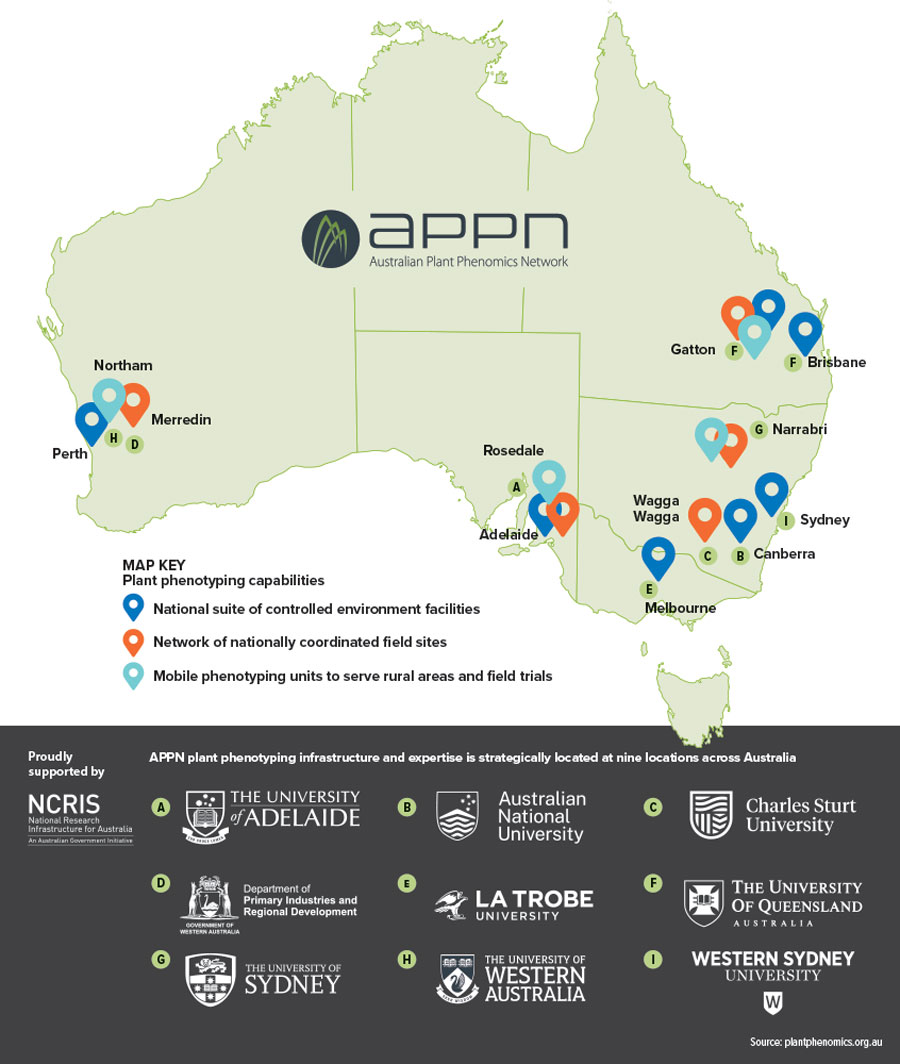Key points
- Linking genetic information and field performance is a vital part of crop improvement
- Phenomics uses technology such as cameras, sensors, robotics and drones to accurately measure physiological traits and gene expression
- Australian Plant Phenomics Network (APPN) is comprised of nine nodes across Australia to accelerate breeding outcomes for challenges such as drought, heat, frost and soil salinity
- APPN provides crop researchers and industry with access to advanced phenotyping infrastructure in controlled environments, at field sites and via mobile phenotyping units for deployment in remote areas
While crop scientists now have access to the genetic code of most crops, including wheat and barley, linking genetic information to field performance requires a crucial additional step – phenotyping, or plant phenomics.
Plant phenomics pairs sophisticated laser scanners, cameras, environmental sensors, robotics and drones with analysis of the collected data to measure traits such as nitrogen content, growth rate, leaf area, stress tolerance or shoot architecture.
This can be done in controlled environments to study specific traits in isolation, or in the field to test the real-world performance of new lines.
Traditionally, measuring phenotypic traits has been slow, labour-intensive and relatively subjective – especially when using visual scores to gauge disease resistance. Advanced imaging and analytics provide researchers with faster, more-objective results.
Critically, these digital systems gather multidimensional growth data non-destructively, so plant performance can be measured across the entire growth phase.
The Australian Plant Phenomics Network (APPN) provides a national plant phenotyping infrastructure supported by specialist expertise in botany, imaging systems, mechatronics, computer science and data analysis.
Supported by $60 million in core funding from the Australian Government’s National Collaborative Research Infrastructure Strategy (NCRIS), plus co-contributions from partner institutions, state governments and GRDC, its mandate is to accelerate the development of climate-resilient crops for food and beverage production, plant-based pharmaceuticals and vaccines.

APPN operates growth rooms with precisely controlled light, temperature, humidity and irrigation conditions, greenhouses and field trial sites. Sensing technologies include RGB (red, green, blue), infrared and light detection and ranging (LiDAR) scanners that can create detailed images or 3D point clouds of individual plants.
Hyperspectral scanners are also used to identify indicators of plant stress invisible to the naked eye, while a range of environmental sensors record critical growing conditions.
Additionally, the Plant Accelerator®, APPN’s node at the University of Adelaide, operates a fully automated X-ray computed tomography (CT) scanner, which can image plant structures and roots within soil columns. The technology has already been used for investigating stem structures to address barley head loss and cereal spike architecture in the quest for more frost tolerant crops.
APPN chief executive officer Richard Dickmann says the organisation enjoys a productive relationship with GRDC spanning numerous research projects.
“Australia’s grains industry is enormously important for the national economy and global food security, while our soils, environment and changing climate all present challenges that need to be understood and addressed as quickly as possible,” he says.
Plant phenomics accelerates the delivery of more-resilient, higher-yielding crops and more-sustainable farming practices.
Recognising these benefits, GRDC has made several direct investments in APPN infrastructure over the years, including co-supporting installation of the X-ray CT system and upgrades to biosecurity glasshouses.
GRDC is also supporting the purchase of six mobile phenotyping units as part of this expansion. Enabling phenotyping in remote locations, each unit will carry matching LiDAR, RGB and hyperspectral systems and data will be collected via uniform pathways so they can be compiled into national data assets.
GRDC senior manager of enabling technologies Tom Giles says APPN’s data-gathering capabilities will be complemented by the interpretive capabilities of GRDC’s Analytics for Australian Grains Initiative (AAGI).
“APPN infrastructure can generate high-resolution data from the field, while the AAGI group will provide analytics support for researchers who need it,” he says.
“GRDC sees phenomics and analytics as the key to saving crop research time and money.
“It means grains field researchers can accurately characterise key traits and gain greater insights to support crop genetic improvement and agronomic RD&E.”
More information: David Foxx, david.foxx@agcommunicators.com.au

























































